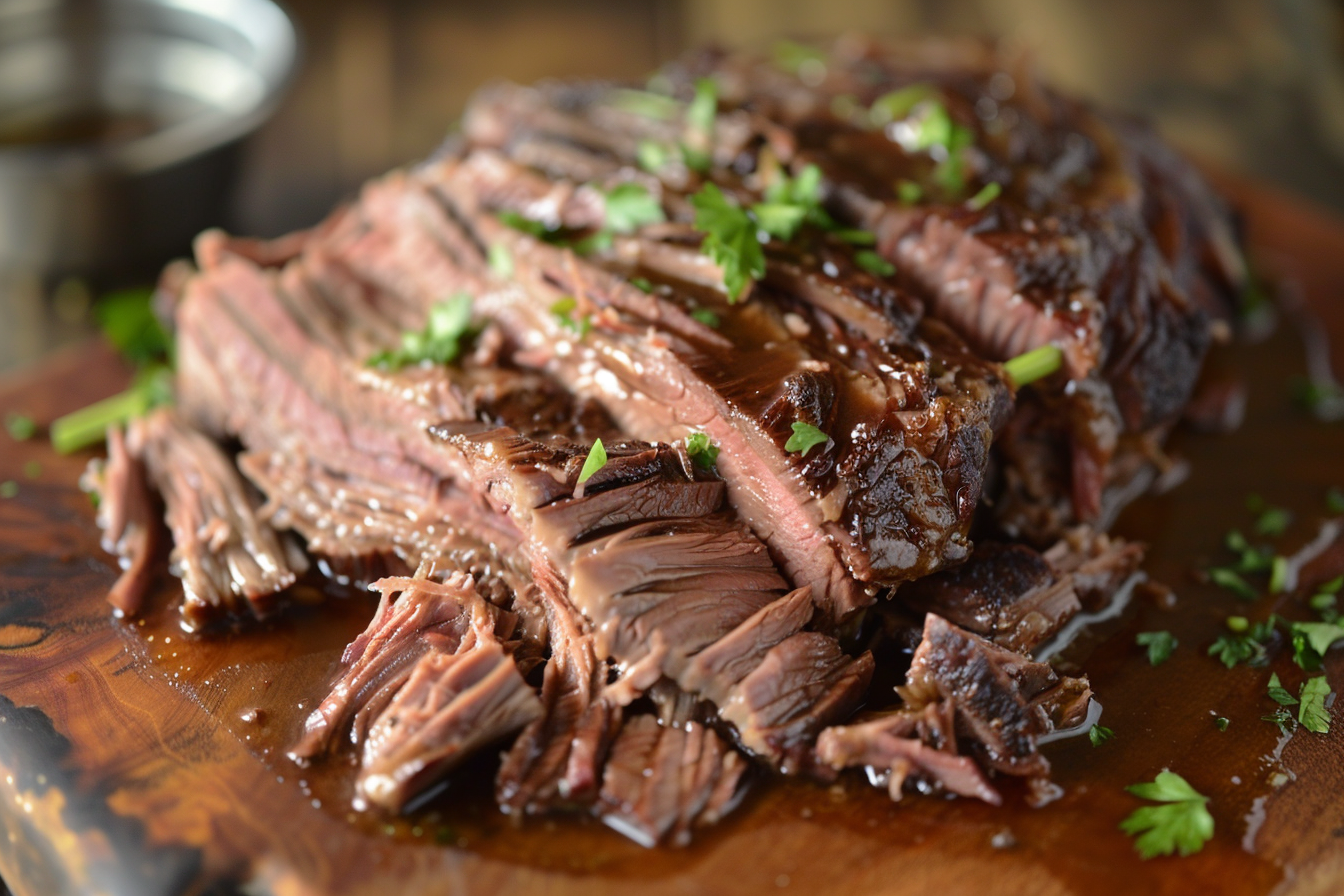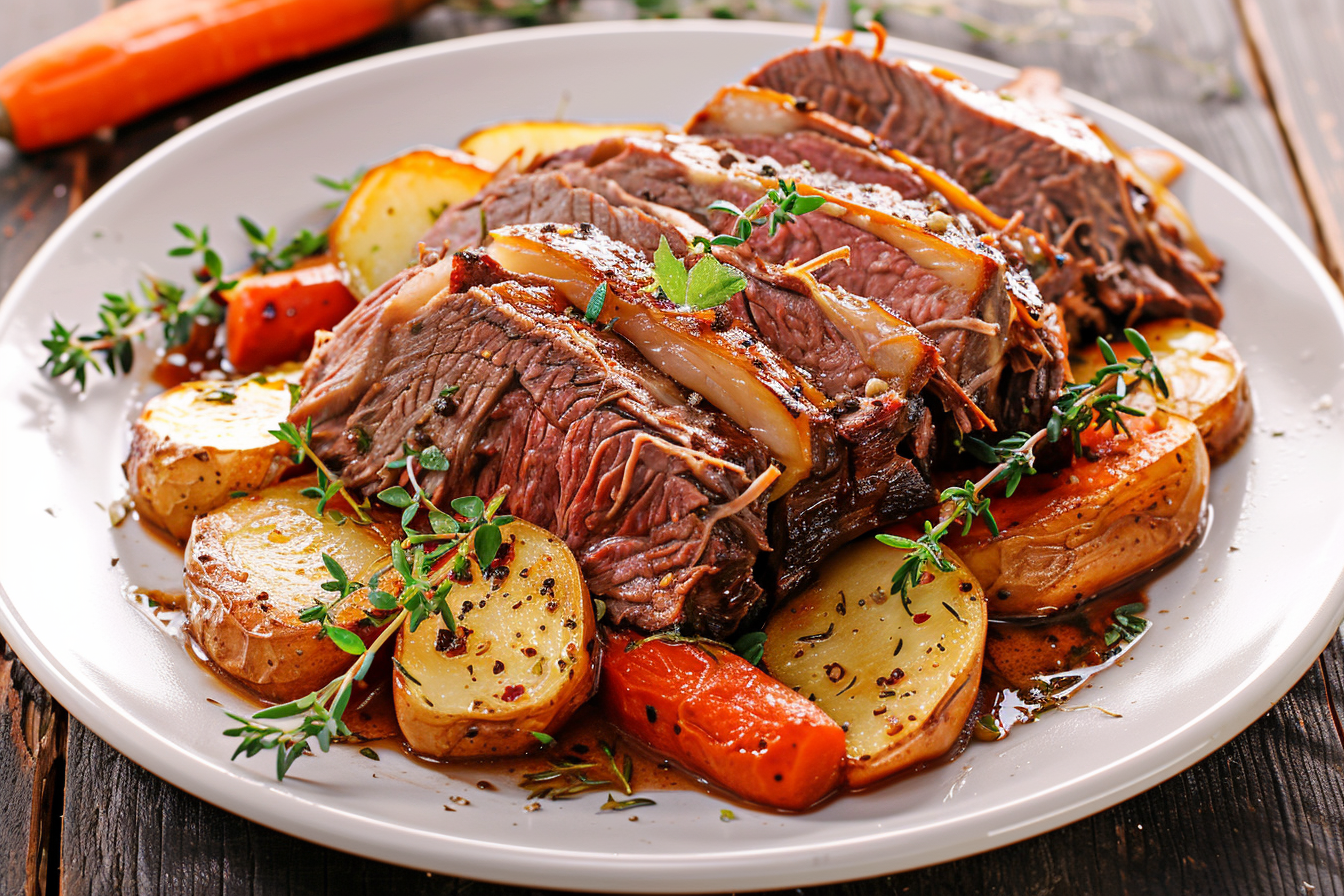Discover the art of perfecting Chuck Roast Recipes : Chuck roast stands as one of the most cherished cuts of beef, favored for its deep flavor and versatility in countless culinary creations. Originating from the shoulder section of the cow, this cut is robust with a rich marbling of fat that promises succulence and taste. The popularity of chuck roast spans various cuisines, making it a go-to choice for comfort foods around the globe.
This cut’s adaptability is showcased in its ability to be transformed through numerous cooking methods. Whether it’s braised slowly in a hearty stew, roasted to perfection in the oven, or shredded for a tender sandwich filling, chuck roast offers a foundation for a multitude of flavorful dishes.
Typical recipes that highlight the potential of chuck roast include traditional pot roasts, savory stews, and Mexican-inspired barbacoa. Each preparation method leverages the cut’s natural properties to enhance flavor and tenderness, ensuring a satisfying meal. The ability to absorb flavors and break down into a tender, pull-apart texture makes chuck roast a favored choice among both home cooks and professional chefs alike.
What is Chuck Roast ?

Chuck roast is a beef cut derived from the chuck, or the shoulder region of the cow. This region encompasses sections of the neck, shoulder blade, and upper arm, which typically feature more muscle and greater amounts of connective tissue as a result of the animal’s frequent movement. As a result, chuck roast is characterized by a rich marbling of fat and a dense texture that is perfect for slow cooking methods.
Texture and Flavor Profile
The texture of chuck roast is notably less tender than more premium cuts due to its high collagen content. However, this feature is precisely what makes it ideal for slow cooking, as the long cooking processes allow the collagen to break down into gelatin, tenderizing the meat and imbuing it with moisture. This transformative process results in a cut that is succulent, tender enough to melt in your mouth, and bursting with flavor.
The flavor profile of chuck roast is deep and beefy, with the fat content significantly enhancing its richness and providing a succulent, satisfying taste. This robust flavor makes chuck roast particularly well-suited to dishes that feature a hearty sauce or gravy, as it can stand up to and complement strong, rich seasonings and ingredients.
Benefits of Using Chuck Roast in Recipes
Using chuck roast in recipes offers several benefits:
Economical: Chuck roast is generally more affordable than cuts like ribeye or sirloin, making it a cost-effective option for family dinners and large gatherings.
Flavorful: The natural marbling and muscle of the chuck impart a deep, beefy flavor that enhances any dish it’s used in.
Versatile: This cut is incredibly versatile, able to be cooked in a pot roast, stewed, braised, or even ground for burgers, providing plenty of culinary options.
Forgiving: Due to its fat and connective tissue content, chuck roast is a forgiving cut to cook, often remaining moist and tender even with extended cooking times, which is ideal for less experienced cooks or those experimenting with slower cooking methods.
Selecting the Perfect Chuck Roast
Choosing the right chuck roast can make a significant difference in your cooking results. Here are some essential tips on what to look for when buying this popular cut and how to store and prepare it for the best culinary outcomes:
What to Look for When Buying:
Marbling: Look for chuck roast with good marbling. The white flecks of fat within the meat are crucial as they melt during cooking, infusing the roast with rich flavor and juiciness.
Color: The meat should have a bright, cherry-red color. Avoid pieces that look dull or have brownish hues, as these may indicate age or poor handling.
Size and Thickness: Choose a chuck roast that is evenly thick. This consistency helps in cooking the roast evenly. Additionally, take into account the size according to the required number of servings; a standard chuck roast usually weighs between 2.5 to 4 pounds.
Storing and Preparing for Cooking:
Storage: If not cooking immediately, you can store chuck roast in the refrigerator for 3-5 days. For longer storage, wrap it tightly in freezer paper or a heavy-duty plastic bag and freeze it, which can preserve its quality for up to 6 months.
Preparation: Before cooking, bring the chuck roast to room temperature for more even cooking. Trim any excess fat if desired, although keeping some fat can enhance flavor and moisture during cooking. If marinating, ensure that the roast is fully coated and refrigerated, allowing the flavors to permeate deeply.
Preparing Chuck Roast for Cooking

Proper preparation of chuck roast is essential for maximizing flavor and achieving the best texture in your finished dish. The Seasoning, marinating, and the searing are key steps that can significantly enhance the taste and appeal of chuck roast.
Seasoning Chuck Roast:
This step is crucial as it adds depth and enhances the natural flavors of the meat. Follow these steps for effective seasoning:
- Salt and Pepper: Generously season the chuck roast with coarse salt and freshly ground black pepper. Salt not only enhances flavor but also helps break down proteins, resulting in a more tender roast.
- Herbs and Spices: Depending on your recipe, you can incorporate dried herbs such as thyme, rosemary, or bay leaves, which enhance the hearty flavor of chuck roast.For a more intense flavor profile, consider adding spices such as garlic powder, onion powder, or smoked paprika.
Marinating Chuck Roast:
While not always necessary, marinating can infuse the chuck roast with additional flavors and further tenderize the meat.
- Choosing a Marinade: Use acidic components like vinegar, lemon juice, or wine mixed with oil and herbs/spices to create a marinade. This helps soften the meat’s texture while adding more flavor dimensions.
- Marinating Time: For best results, marinate the chuck roast in the refrigerator for at least a few hours or overnight. Ensure the meat is fully submerged in the marinade and covered with plastic wrap or placed in a zip-lock bag.
Searing Chuck Roast:
Searing the chuck roast before slow cooking or braising caramelizes the surface of the meat, enhancing its flavor through the Maillard reaction.
- How to Sear: Heat a heavy skillet or Dutch oven over high heat. Add a little oil that has a high smoke point, such as vegetable or canola oil. Once hot, place the chuck roast in the pan. Let it cook undisturbed for a few minutes until it develops a dark, caramelized crust, then flip it to sear the other side.
- After Searing: Once seared, remove the roast from the pan. You can proceed to cook it using your chosen method, such as slow cooking or oven roasting, where the searing will have added a layer of complexity to the flavor.
Cooking Methods Explained
Chuck roast can be prepared using various cooking methods, each bringing out a unique set of flavors and textures in the meat. Here’s an overview of three commonly used techniques: slow cooking, braising, and roasting, including their benefits and recommended dishes.
Slow Cooking:
- Description: Slow cooking involves cooking the chuck roast at a low temperature for several hours, typically in a slow cooker or a low oven. This method allows the tough connective tissues in the meat to break down gradually, resulting in extremely tender meat.
- Advantages: It is a largely hands-off cooking method that lets you set it and forget it. The extended cooking time infuses the meat with flavors from added herbs, spices, and liquids.
- Best for: Dishes like classic pot roast or shredded beef for tacos, where the meat needs to be tender enough to fall apart.
Braising:
- Explanation: Braising begins with searing the meat before gently cooking it over low heat in a covered pot with a modest amount of liquid. This method can be applied either in the oven or on the stovetop.
- Advantages: This method combines the rich flavors achieved from searing with the deep, complex tastes developed through slow cooking in liquid, resulting in a moist and flavorful dish.
- Best for: Hearty dishes like beef bourguignon or any other dish where you want the meat to be flavorful and tender but still hold its shape.
Roasting:
- Description: Roasting involves cooking the chuck roast uncovered in an oven, allowing the surface of the meat to brown and crisp up.
- Advantages: Roasting is quicker than braising or slow cooking and can produce a beautifully caramelized exterior with a juicy interior.
- Best for: Sunday roasts or when you prefer a slightly firmer texture and caramelized crust, often served with roasted vegetables.
Step-by-Step Cooking Guide
Here’s a simple step-by-step guide to making a basic chuck roast, with variations to suit different flavors and dietary preferences:
- Preparation:
- Start by seasoning the chuck roast generously with salt, pepper, and any other spices your recipe calls for.
- You can marinate the roast following the guidelines in the preparation section, particularly if you’re targeting a certain flavor profile.
- Searing:
- Heat some oil in a heavy skillet or Dutch oven over high heat. Sear the roast on all sides until it develops a rich brown crust. This particular step is essential for enhancing the flavor.
- Cooking:
- For Slow Cooking: Place the seared roast in a slow cooker. Add a mix of broth, wine, or water, along with onions, carrots, and potatoes, or other vegetables and aromatics. Cook on low for 8 hours or on high for about 4-5 hours.
- For Braising: After searing, place the roast back into the Dutch oven, add enough broth to come up halfway up the sides of the roast, along with your chosen vegetables and aromatics. Cover and place in a preheated 325°F oven for about 3-4 hours.
- For Roasting: After searing, place the roast in a roasting pan and into a preheated 375°F oven. Cook for about 1 hour and 15 minutes, or until the meat reaches the desired doneness.
- Serving:
- Let the roast rest before slicing or shredding. Serve with the cooking vegetables and juices.
Variations:
- Flavor Variations: Add different herbs and spices to match the cuisine you’re aiming for—rosemary and thyme for a classic touch, chipotle, and lime for a Mexican flavor, or star anise and soy for an Asian twist.
- Dietary Preferences: For a lower fat option, trim excess fat before cooking or look for a leaner cut of chuck. For gluten-free requirements, ensure that all added packaged ingredients are certified gluten-free.


